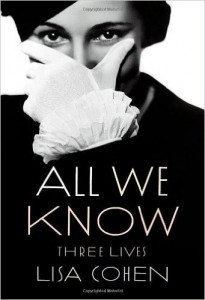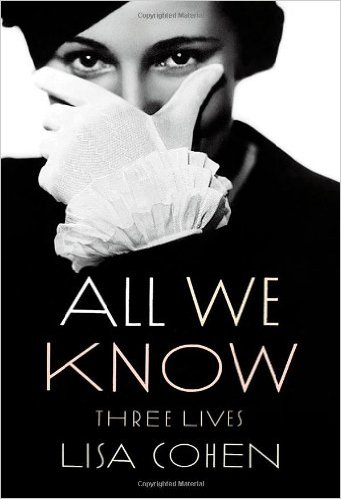 All We Know: Three Lives
All We Know: Three Lives
by Lisa Cohen
Farrar, Straus and Giroux. 429 pages, $30.
BACK in the glory days of 1970s, “second wave feminism,” feminists sat in consciousness-raising groups across America talking about their lives and the lives of their mothers and grandmothers. We wanted to know about the dreams and aspirations of women’s lives. We yearned to document what we now term “herstory.” In All We Know: Three Lives, Lisa Cohen, who teaches at Wesleyan University, rescues from history’s dustbin the lives of three extraordinary, glamorous, brilliant, independent lesbians. Cohen’s project is a welcome addition to the Herstory Project.
Cohen profiles the lives of Esther Murphy (1897-1962), Mercedes de Acosta (1893-1968), and Madge Garland (1898-1990), three names that are virtually unknown to readers today. Yet in their heyday they occupied central positions in the intellectual, cultural, fashion, and social circles of Europe and North America.
Esther Murphy, whose family owned the Mark Cross leather goods company and whose brother was Gerald Murphy, artist and friend of F. Scott Fitzgerald and Ernest Hemingway, was famous for her brilliance and vast storehouse of historical knowledge. Her friends and lovers included Edmund Wilson, F. Scott Fitzgerald, society hostess Muriel Draper, writer Natalie Barney, journalist Janet Flanner, Gertrude Stein, novelist Sybille Bedford, and many others. She married twice. Her first marriage was to John Strachey, and her second was to Chester A. Arthur III, grandson of the president. Number Three, also known as Gavin, was bisexual and, according to Cohen, one of the founders of the Radical Faeries.
Cohen tells us that Murphy did not finish any of her major writing projects, including her magnum opus on the life of Madame de Maintenon. She was a nonstop talker and an alcoholic. She knew everything and everyone, yet she was unable to live up to her own aspirations. Cohen uses Murphy’s habit of starting all her conversations with the phrase “All we know” as the title for the book.
The second section is devoted to the life of Mercedes de Acosta, who came from a wealthy Spanish family. Her lifelong pursuit was to collect celebrities both as lovers and as memorabilia. Her conquests rival those of Don Giovanni. She purportedly romanced Greta Garbo, Isadora Duncan, Marlene Dietrich, the actress Eva Le Gallienne, and legions more. She spent her life memorializing the accomplishments of other women.
The final third of the book focuses on the life of Madge Garland, an early editor of British Vogue. In comparison to Murphy and de Acosta, Garland was a positive dynamo of creativity and productivity. In the early 1920s, she and her companion/ lover, Vogue editor Dorothy Todd, made British Vogue not just a fashion magazine but a place to publish the works of Modernist artists and writers such as Virginia Woolf, Gertrude Stein, Cecil Beaton, and countless others.
Cohen details Garland’s trials and tribulations in love and work. We learn that in the 1950’s she was appointed the first professor of fashion at the Royal College of Art. She wrote articles and books, lectured, and in her later years traveled.
All We Know: Three Lives is an exploration of the lives of three pre-Stonewall lesbians. We learn about a world where there were so many closets that a person could get lost trying to figure out which one to hide in or to emerge from. All three women married in order to maintain some façade of respectability. Each one had to perform femininity in order to survive in a world that defined the lesbian as a criminal. They lived in the shadows of the horrors of the trials of Oscar Wilde and Radclyffe Hall. They belonged to a generation of “new women” who unshackled themselves from Victorian corseting and lived sexually free and independent lives. Despite the prevailing sexism and discrimination, each of these women managed to liberate herself from stultifying gender rules and roles.
Cohen asks us to question our assumptions about failure and success and how we perform sexual identity and gender roles. Despite the fact that these women are barely footnotes in patriarchal history, they are worthy additions to the lesbian herstory library. Included in the book are wonderful photographs, over 48 pages of extensive notes, and an excellent index. My one criticism is that Cohen resorts to far too many lists of celebrities in order to show that her subjects were well connected. At times, it felt like I was in attendance at a dizzying array of campy cocktail parties à la Noël Coward: “Really, darling!”
________________________________________________________
Irene Javors, a psychotherapist based in New York, is the author of Culture Notes: Essays on Sane Living.






